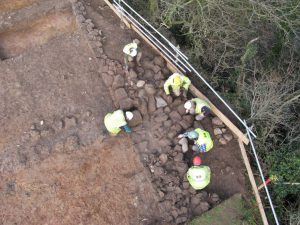A relatively large number of what are probably Neolithic arrowheads were retrieved from the Palaeochannel and the scatter of lithic material adjacent to it. These took two principal forms: leaf-shaped and chisel-ended (or transverse). The leaf-shaped points occurred in a range of sizes and were often finely worked, showing good skill in manufacture, with both sides being invasively retouched (modified). There was also some evidence of on-site production, with an arrowhead blank (missing the invasive retouch and therefore not completed) occurring in association with an assemblage of very fine pressure flakes. These arrowheads, made predominantly from flint (with one chert example), would have been effective projectile points that could have been used for hunting both large and small game.

The arrowhead chosen as the logo for this site is a good example of the leaf-shaped form, and not only shows the fine invasive retouch, but also has traces of an adhesive substance still clearly visable on the surface which is thought to be a very rare surviving example of prehistoric glue.


